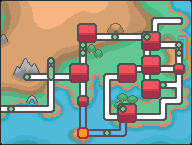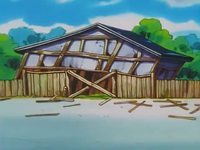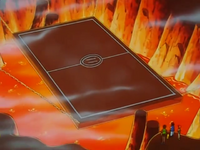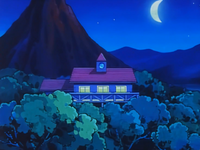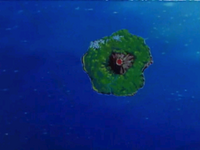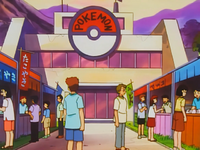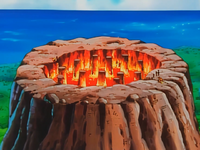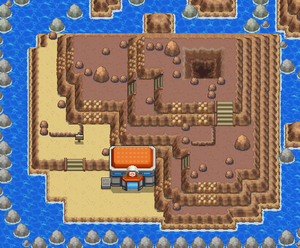
|
This article is incomplete.
Please feel free to edit this article to add missing information and complete it.
Reason: Needs LGPE layout image
|
- If you were looking for the chapter in Pokémon Zensho, see PZ08.
Cinnabar Island (referred to in Japanese as both グレン島 Guren Island and グレンタウン Guren Town) is a large island located off the southern coast of the Kanto region, south of Pallet Town. It is home to a large volcano. Blaine was once the resident Gym Leader specializing in Fire-type Pokémon, but as of Generation IV, Cinnabar Island no longer has a Gym. Cinnabar is a kind of red mineral, associated with hot springs and volcanoes. The island is connected to the mainland by two water routes: Route 20 in the east and Route 21 in the north, leading to Fuchsia City and Pallet Town, respectively.
The journals scattered throughout the abandoned Pokémon Mansion reveal that Mewtwo was created there. The scientists at the Cinnabar Lab (known as the Pokémon Lab prior to Generation VII) have the ability to resurrect Pokémon from their Fossils.
As seen in Generations II and IV, three years after the events of Generations I and III, a volcano erupted on the island, destroying everything. The only building present is a Pokémon Center, with the Cinnabar Gym having been relocated to the Seafoam Islands.
Names

|
This section is incomplete.
Please feel free to edit this section to add missing information and complete it.
Reason: Check other in-game references
|
In the Japanese versions, Cinnabar Island has two distinctive names: グレン島 Guren Island and グレンタウン Guren Town.
In an old Pokémon.com summary, Cinnabar Island was called by its Japanese name of Guren Island (transliterated as Glen Island).[1]
Generations I, III, and VII
In the Generation I games, it is referred to as simply "Guren" (グレン) on the Town Map just like other cities and towns. The island's signpost calls it Guren Town, whereas the Cinnabar Gym signpost calls it Guren Island.
In Pokémon FireRed and LeafGreen, as well as Let's Go, Pikachu! and Let's Go, Eevee!, the situation is the same. Additionally, the Town Map calls it Guren Island due to it being its location ID but its guide about the Pokémon Mansion calls it Guren Town instead.
Generations II and IV
In the Generation II games and Pokémon HeartGold and SoulSilver, the island's signpost, the Cinnabar Gym signpost and its relocation notice call it Guren Town. The location ID is Guren Island in Generation II and Guren Town in HeartGold and SoulSilver.
Slogan
Generations I-III and VII
The Fiery Town of Burning Desire (Japanese: グレンの あかは じょうねつの いろ Guren's red is the color of passion.)
Generation IV
The Ravaged Town of the Past (Japanese: おしながされた かこの まち The ravaged town of the past)
Places of interest
Pokémon Mansion
- Main article: Pokémon Mansion (Kanto)
The Pokémon Mansion is a decrepit, burned-down mansion on Cinnabar Island. It got its name because a famous Pokémon Researcher once lived there. The Pokémon Mansion has four different floors. Doors can be unlocked in the Mansion by pressing switches hidden in Mewtwo statues. To access the Cinnabar Island Gym in Generations I and III, the main character has to enter the mansion and find the Secret Key to unlock the door of the Gym. Many burglars come to the mansion, trying to steal valuable items that may have been lost in the wreckage, challenging the player to a battle when spotted. Amongst the rubble and wreckage is information that the scientists who once worked there obtained a Mew and impregnated it with the genetically altered Mewtwo, who destroyed the mansion in its escape.
Cinnabar Lab
- Main article: Cinnabar Lab
The Cinnabar Lab, known as the Pokémon Lab prior to Let's Go, Pikachu! and Let's Go, Eevee!, is a laboratory located on Cinnabar Island. It was founded by Dr. Fuji and appears in the Generation I games and their remakes. In Generations I and III, the west room of the Cinnabar Lab has two people who will offer to trade Pokémon. The old man will offer his Electrode for a Raichu, and the girl will want to trade her Tangela for a Venonat. In the center room, there is a man who will teach Metronome once to one of the player's Pokémon; in Generation I, he gives away TM35 (Metronome). In the east room, there is a scientist who will revive the Fossils the player obtained at Mt. Moon and from the Pewter City Museum and a person who will trade his Seel for a Ponyta. In Silph Co., there is a Pokémon Report stating that Cinnabar Lab created Porygon.
Volcano
There is a volcano on Cinnabar Island which gives it its name. In Generation I and Generation III, the volcano that appears on Cinnabar Island cannot be accessed. In the anime, the volcano is a prominent feature of the island, and is where the Cinnabar Gym is located, split into two sections. One is inside of the volcano, and has an arena suspended over the lava inside one of the chambers, while the other is atop the volcano's crater. In Generation II and IV, three years after the events of Generation I and III, the volcano erupted on the island, destroying everything, and only the Pokémon Center has been rebuilt. What appeared to be a rain-filled crater could also be seen in Pokémon Gold, Silver, and Crystal. In HeartGold and SoulSilver, the exterior of the volcano can be scaled with Rock Climb. Judging by the maps of all four generations, the volcano originated where the Gym once stood.
Cinnabar Gym
- Main article: Cinnabar Gym
The Cinnabar Gym is the official Gym of Cinnabar Island, it is based on Fire-type Pokémon and the Gym Leader is Blaine. Trainers who defeat him receive the Volcano Badge. The player is unable to enter the Gym at once; only when they obtain the Secret Key from the Pokémon Mansion can they unlock the door to the Gym. The Cinnabar Gym is a high-tech affair featuring a series of sealed doors. Trivia questions about various Pokémon must be answered to unseal the doors. However, when the player fails to answer a trivia question correctly, a battle with either a Burglar or Super Nerd results, an alternative to unsealing the doors. In Generations II and IV, Blaine's original Gym on Cinnabar Island was destroyed by a volcanic eruption. This forced him to relocate to a cave in the Seafoam Islands.
Demographics
Pokémon Red, Blue, and Yellow
Cinnabar Island has a population of 33.
Pokémon Gold, Silver, and Crystal
Cinnabar Island has a population of 6, all residing in the Pokémon Center. This is because every other building was destroyed by a volcanic eruption.
Pokémon FireRed and LeafGreen
In Pokémon FireRed and LeafGreen, before the destruction of the island in the Generation II and Generation IV games, Cinnabar Island has a population of 36.
Pokémon HeartGold and SoulSilver
Cinnabar Island has a population of nine, making it one of the smallest towns in the Pokémon world. The volcano eruption destroyed most of the island, with the Pokémon Center being the only building remaining.
Poké Mart
Items
Pokémon
Generation I
| Pokémon
|
Games
|
Location
|
Levels
|
Rate
|
| Fishing
|
|
|
R
|
B
|
Y
|
|
5
|
100%
|
|
|
R
|
B
|
Y
|
|
10
|
50%
|
|
|
R
|
B
|
Y
|
|
10
|
50%
|
|
|
R
|
B
|
Y
|
|
15, 30
|
40%
|
|
|
R
|
B
|
Y
|
|
15
|
25%
|
|
|
R
|
B
|
Y
|
|
15
|
25%
|
|
|
R
|
B
|
Y
|
|
15
|
25%
|
|
|
R
|
B
|
Y
|
|
15
|
25%
|
|
|
R
|
B
|
Y
|
|
10, 15
|
60%
|
| A colored background means that the Pokémon can be found in this location in the specified game. A white background with a colored letter means that the Pokémon cannot be found here.
|
Generation II
| Pokémon
|
Games
|
Location
|
Levels
|
Rate
|

|

|

|
| Surfing
|
|
|
G
|
S
|
C
|
|
30-39
|
90%
|
|
|
G
|
S
|
C
|
|
35-39
|
10%
|
| Fishing
|
|
|
G
|
S
|
C
|
|
10
|
85%
|
|
|
G
|
S
|
C
|
|
10
|
15%
|
|
|
G
|
S
|
C
|
|
20
|
35%
|
|
|
G
|
S
|
C
|
|
20
|
35%
|
|
|
G
|
S
|
C
|
|
20
|
20%
|
|
|
G
|
S
|
C
|
|
20
|
10%
|
|
|
G
|
S
|
C
|
|
40
|
40%
|
|
|
G
|
S
|
C
|
|
40
|
30%
|
|
|
G
|
S
|
C
|
|
40
|
20%
|
|
|
G
|
S
|
C
|
|
40
|
10%
|
| A colored background means that the Pokémon can be found in this location in the specified game. A white background with a colored letter means that the Pokémon cannot be found here.
|
Generation III
| Pokémon
|
Games
|
Location
|
Levels
|
Rate
|
| Surfing
|
|
|
FR
|
LG
|
|
5-40
|
100%
|
| Fishing
|
|
|
FR
|
LG
|
|
5
|
100%
|
|
|
FR
|
LG
|
|
5-15
|
60%
|
|
|
FR
|
LG
|
|
5-15
|
20%
|
|
|
FR
|
LG
|
|
5-15
|
20%
|
|
|
FR
|
LG
|
|
5-15
|
60%
|
|
|
FR
|
LG
|
|
5-15
|
20%
|
|
|
FR
|
LG
|
|
15-25
|
40%
|
|
|
FR
|
LG
|
|
15-25
|
40%
|
|
|
FR
|
LG
|
|
15-25
|
40%
|
|
|
FR
|
LG
|
|
15-25
|
40%
|
|
|
FR
|
LG
|
|
15-25
|
15%
|
|
|
FR
|
LG
|
|
25-35
|
4%
|
|
|
FR
|
LG
|
|
25-35
|
4%
|
|
|
FR
|
LG
|
|
25-35
|
1%
|
|
|
FR
|
LG
|
|
25-35
|
1%
|
| A colored background means that the Pokémon can be found in this location in the specified game. A white background with a colored letter means that the Pokémon cannot be found here.
|
Generation IV
| Pokémon
|
Games
|
Location
|
Levels
|
Rate
|
| Surfing
|
|
|
HG
|
SS
|
|
30-35
|
90%
|
|
|
HG
|
SS
|
|
35
|
10%
|
| Fishing
|
|
|
HG
|
SS
|
|
10
|
95%
|
|
|
HG
|
SS
|
|
10
|
5%
|
|
|
HG
|
SS
|
|
20
|
60%
|
|
|
HG
|
SS
|
|
20
|
30%
|
|
|
HG
|
SS
|
|
20
|
7%
|
|
|
HG
|
SS
|
|
20
|
3%
|
|
|
HG
|
SS
|
|
40
|
60%
|
|
|
HG
|
SS
|
|
40
|
30%
|
|
|
HG
|
SS
|
|
40
|
7%
|
|
|
HG
|
SS
|
|
40
|
3%
|
| A colored background means that the Pokémon can be found in this location in the specified game. A white background with a colored letter means that the Pokémon cannot be found here.
|
Generation VII
| Pokémon
|
Games
|
Location
|
Levels
|
Rate
|
| While riding a Flying Pokémon
|
|
|
P
|
E
|

|
Midair
|
|
3-56
|
60%
|
|
|
P
|
E
|

|
Midair
|
|
3-56
|
35%
|
|
|
P
|
E
|

|
Midair
|
|
3-56
|
5%
|
| Special Pokémon
|
|
|
P
|
E
|
|
44
|
Unlimited
|
|
|
P
|
E
|
|
44
|
Unlimited
|
| A colored background means that the Pokémon can be found in this location in the specified game. A white background with a colored letter means that the Pokémon cannot be found here.
|
Trainers
Generation VII
| Trainer
|
Pokémon
|
| After becoming Champion
|
|
|
|
|
|
Differences between generations
Cinnabar Island has changed dramatically between Generations I and II as the city has been totally replaced by a large erupted volcano, removing everything except for the Pokémon Center. After the eruption, the Gym was relocated to the Seafoam Islands. Blue can be first found at Cinnabar Island, because he was in a bad mood and decided to take a stroll there. In Generation III, there are a few changes with the visual design, as the Pokémon Mansion and Pokémon Lab are slightly larger along with more sandy beach areas. The first and last questions in the Cinnabar Gym have also been changed slightly for clarification. In Generation IV, the island stays much the same as Generation II, although the volcano is now climbable by Rock Climb.
In the spin-off games
Pokémon Pinball
In Pokémon Pinball, Cinnabar Island appears on the Red and Blue tables; catchable Pokémon include Growlithe, Ponyta, Grimer, Koffing, Tangela, Magmar, Omanyte, Kabuto and Aerodactyl.
In Pokkén Tournament
While Cinnabar Island does not appear in Pokkén Tournament, when fighting Shadow Mewtwo, sometimes Nia will mention having read the "Cinnabar Island docs" on Mewtwo. However, the words "Cinnabar Island" aren't in text, and thus are only noticeable if her voice is turned on.
In the anime
Main series
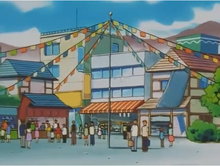
Cinnabar Island in the
animeIn the anime, Cinnabar Island is depicted as a tourist resort after the Cinnabar Gym Leader, Blaine, closed the Cinnabar Gym down due to the large influx of challengers who cared more about souvenirs than battling. However, Blaine secretly constructed a new Gym inside the Cinnabar Volcano.
In Riddle Me This, Ash and his friends arrived on Cinnabar Island for Ash's seventh Badge. However, they were dismayed to learn that the Gym had been closed down. After saving the Pokémon at the Pokémon Lab from being stolen by Team Rocket, a riddle-loving man told the group about Blaine's new secret Gym and gave them a hint about its location. The Gym's secret entrance turned out to be located next to the hot spring at the riddle man's "Big Riddle Inn". Inside the Gym, Ash and his friends found the riddle man, who turned out to be Blaine in disguise. Ash started a Gym battle with Blaine, but had difficulties during the entire match.
In Volcanic Panic, Ash forfeited the Gym battle and retreated to heal his Pokémon. Meanwhile, Team Rocket sneaked into the Gym to steal Blaine's Magmar, but their actions at the heart of the volcano threatened to make it erupt and destroy Cinnabar Island. Ash and his friends assisted Blaine in stopping the eruption, and, as a sign of gratitude, Blaine agreed to have a rematch with Ash. Since the Gym had been destroyed during the incident, the battle took place at the summit of the volcano. To Ash's surprise, his usually disobedient Charizard offered to battle Blaine's Magmar. After an eventful battle, Charizard emerged victorious, earning Ash the Volcano Badge. Ash and his friends left the island in the next episode, headed for Viridian City.
Gallery
Pokémon Origins
Cinnabar Island was visited by Red in File 3: Giovanni. During his visit, he first explored the Pokémon Mansion, where he discovered a journal that would later help him identify Cerulean Cave's mysterious Pokémon as Mewtwo. After exploring the Mansion, Red challenged Blaine to a Gym battle and won, earning the Volcano Badge.
In the manga
Pokémon Adventures
Cinnabar Island debuted in Holy Moltres, where Team Rocket was trying to hunt down Blaine on the island because of him leaving them. When Team Rocket threatened Red, Blaine showed himself and rescued him. When they tried to escape, Team Rocket sent Moltres after them. As Blaine knew that they needed a Flying Pokémon to fight Moltres effectively, he sent Red to his secret laboratory to revive his Old Amber. Thanks to the Aerodactyl revived by Red, Team Rocket and Moltres were forced to retreat.
In Putting It on the Line...Against Arcanine, Yellow arrived at Cinnabar Island from the Seafoam Islands. At the top of the volcano, she saw Blaine training with Camper Evan, after which he invited her to his laboratory. They soon received emergency messages from all over Kanto, revealing that the Elite Four had started their attack on the region. Both Blaine and Yellow then departed to launch a direct assault against the Elite Four's base at Cerise Island.
Cinnabar Island made a brief appearance in Double Down Deoxys, when Camper Evan and Super Nerd Miles visited Blaine at his laboratory. Due to the mark left on his arm by Mewtwo's cells, Blaine was able to sense Mewtwo's agitation, speculating that it was due to Mew heading back to the Kanto mainland from Faraway Island.
In Arrival at the Scientific Megalopolis, Sun was revealed to have been born and raised at Cinnabar Island before he moved to Alola.
Trivia
- It was long believed that Cinnabar Island once was the tip of a stratovolcano or a shield volcano since no mountain was visible on the island for the first three generations. This was changed in Pokémon HeartGold and SoulSilver, where a mountainous stratovolcano is actually there and can be reached by using Rock Climb, indicating that the lack of diverse scenery in the past games was the reason for no mountain being there. However, all map artworks throughout the generations have shown the volcano to be there.
- Cinnabar Island has many glitches associated with it in the Generation I games, such as the old man glitch, due to programming oversights on the island's coast. There is also a trick to see a man on the roof of the Gym. However, both of these glitches were fixed in some regional versions.
- Cinnabar Island and Vermilion City are named after the same color in the English versions of the Pokémon games but not in the Japanese versions, since crimson (グレン guren, "crimson lotus") refers to a shade of red while vermilion (クチバ kuchiba, "decayed leaves") refers to a shade of orange. Cinnabar is an orange-red mineral that produces the orange-red pigment vermilion. This explains why Cinnabar Island is colored red while Vermilion City is colored orange in the Generation I games when played with the Super Game Boy enhancements enabled on a compatible system or with the Game Boy Color enhancements available in the international releases of Pokémon Yellow (including the Virtual Console release).
- It is the southernmost location in both Kanto and Johto that the player can Fly to.
- In Pokémon X and Y, a woman in Kiloude City talks about cooking "Cinnabarian hamburger steak".
- In Generation IV, if the player blacks out or uses Teleport when the Cinnabar Island Pokémon Center was the last Pokémon Center they visited, they will be taken to the last Pokémon Center they had visited prior to Cinnabar Island instead. This is likely to prevent the player from being permanently stranded on Cinnabar Island if their only Pokémon can't learn Surf or Fly and they have no means of obtaining another Pokémon.
|
|
| This video is not available on Bulbapedia; instead, you can watch the video on YouTube here.
|
- Cinnabar Island is based on Izu Ōshima, an inhabited volcanic island off the coast of Japan. Izu Ōshima is the largest and closest of Tokyo's outlying islands.
Name origin
| Language
|
Name
|
Origin
|
| Japanese
|
グレンじま Guren Jima
グレンタウン Guren Town
|
From 紅蓮色 guren-iro, the crimson color of red lotus
|
| English
|
Cinnabar Island
|
From cinnabar, an orange-red mineral used to produce vermilion pigment
|
| French
|
Cramois'île
|
From cramoisi, crimson
|
| German
|
Zinnoberinsel
|
From zinnoberrot, carmine
|
| Italian
|
Isola Cannella
|
From cannella, cinnamon
|
| Spanish
|
Isla Canela
|
From canela, cinnamon
|
| Isla Cinnabar*
|
From its English name
|
| Korean
|
홍련섬 Hongnyeon Seom
|
From 홍련 (紅蓮) hongnyeon, red lotus
|
| Chinese (Mandarin)
|
紅蓮島 / 红莲岛 Hónglián Dǎo
紅蓮鎮 / 红莲镇 Hónglián Zhèn
|
From 紅蓮 hónglián, red lotus
|
| 幽谷鎮 Yōugǔ Zhèn*
|
From 幽谷 yōugǔ, glen
|
| Chinese (Cantonese)
|
紅蓮鎮 Hùhnglìhn Jan
|
From 紅蓮 hùhnglìhn, red lotus
|
| 幽谷鎮 Yāugūk Jan*
|
From 幽谷 jāugūk, glen
|
| Danish
|
Cinnabarøen
|
From English name
|
| Indonesian
|
Pulau Glen*
|
Alternate romanization of its Japanese name
|
| Norwegian
|
Øya Cinnabar
|
From English name
|
| Polish
|
Wyspa Cinnabar
|
From its English name
|
| Brazilian Portuguese
|
Ilha Cinnabar*
Ilha de Cinnabar*
Cidade de Cinnabar*
|
From its English name
From its English name
Means Cinnabar City
|
| Russian
|
Остров Киноварь Ostrov Kinovar'
|
From киноварь kinovar', cinnabar
|
| Swedish
|
Cinnabar-ön
|
From English name
|
| Thai
|
เกาะเกรน Keāa Kern
|
Transliteration of Japanese name
|
| Vietnamese
|
Đảo Glen
|
Transliteration of Japanese name
|
References

